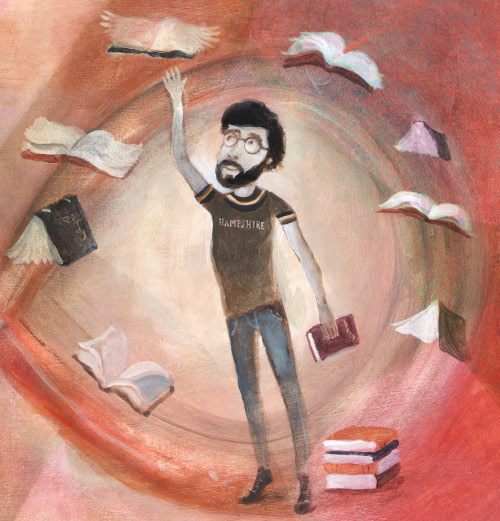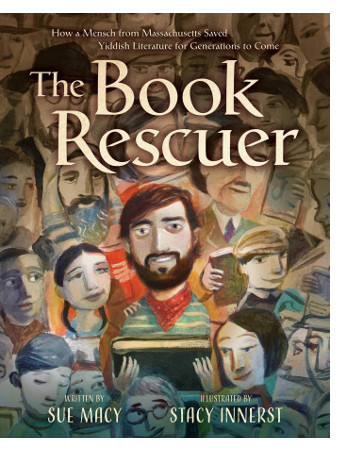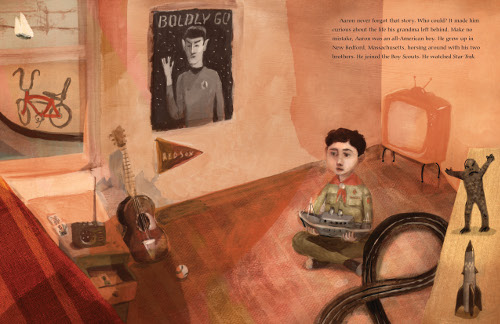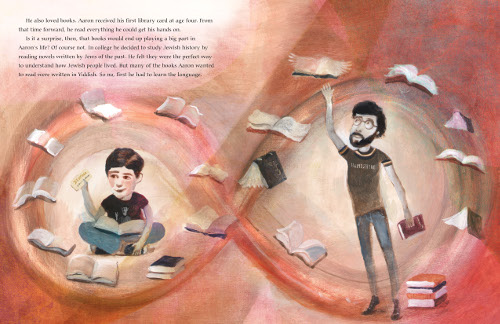The Book Rescuer
 December 3rd, 2019 by jules
December 3rd, 2019 by jules

On the first page of The Book Rescuer: How a Mensch from Massachusetts Saved Yiddish Literature for Generations to Come (Paula Wiseman/Simon & Schuster, October 2019), author Sue Macy speaks invitingly to readers: “Kum aher. Sit down. I want to tell you a story. It starts a long time ago, when Aaron Lansky’s sixteen-year-old grandma left Eastern Europe for the United States.” In sepia tones, illustrator Stacy Innerst shows her packing a suitcase. And in it she places a few books in Yiddish. Those books never made it to her new home; her brother met her in New York City and, telling her that she must break with the past, threw her suitcase into the Hudson River.
 Readers then meet Aaron, her grandson, growing up years later in New Bedford, Mass; he’s an “all-American boy.” He is also curious about the world his grandmother left behind, and he loves books. This is his story, focused on his mission to locate and preserve books in Yiddish. The book includes historical context about the language and how and why books written in Yiddish were difficult to find. Aaron knew they were the “‘portable homeland’ of the Jewish people” and determined to find as many as he could. From his local rabbi, to donations he received in grad school, to asking large Jewish organizations in the U.S., to raiding dumpsters he knew included Yiddish books, to calls he received from people after he founded the Yiddish Book Center in an old factory building, and more — remarkably, Aaron saved, in the end, a million and a half Yiddish books. The recipient of the MacArthur Fellowship (the so-called “genius grant”), Lansky still runs the Yiddish Book Center in Amherst, Massachusetts, writing in the book’s afterword:
Readers then meet Aaron, her grandson, growing up years later in New Bedford, Mass; he’s an “all-American boy.” He is also curious about the world his grandmother left behind, and he loves books. This is his story, focused on his mission to locate and preserve books in Yiddish. The book includes historical context about the language and how and why books written in Yiddish were difficult to find. Aaron knew they were the “‘portable homeland’ of the Jewish people” and determined to find as many as he could. From his local rabbi, to donations he received in grad school, to asking large Jewish organizations in the U.S., to raiding dumpsters he knew included Yiddish books, to calls he received from people after he founded the Yiddish Book Center in an old factory building, and more — remarkably, Aaron saved, in the end, a million and a half Yiddish books. The recipient of the MacArthur Fellowship (the so-called “genius grant”), Lansky still runs the Yiddish Book Center in Amherst, Massachusetts, writing in the book’s afterword:
We’re racing against time to save Jews’ stories as well as their books. We’re training a new generation of Yiddish translators. We’re releasing a new textbook that will make learning Yiddish quicker, easier, and more fun. … I’ll admit it: Racing around in a rattletrap truck in search of dusty books was a lot of fun. But what we’re doing now — opening up those books, excavating the lost civilization they contain, and sharing its treasures with the world — that’s even better.
It’s a spectacular and truly inspiring story, in good hands with Macy, who captures the drama of the book-rescuing and the passion Lansky had (and still has) for his mission. Innerst’s illustrations (as explained in an illustrator’s note in the back) are inspired by Marc Chagall’s work. His palette ranges from sepia tones of the past to warm earth hues of the present, and a passion for the written word and books is an ever-present theme. One spread features Yiddish texts as the very earth on which a community stands; another (pictured below) shows books taking flight, wings sprouting from pages, as a teenage Aaron stands in a circle of them.
Here are some more spreads so that the art can do the talking. …

where her older brother was waiting. …”
(Click spread to enlarge and read text in its entirety)

It made him curious about the life his grandma left behind. …”
(Click spread to enlarge and read text in its entirety)

playing a big part in Aaron’s life? Of course not. …”
(Click spread to enlarge and read text in its entirety)
THE BOOK RESCUER: HOW A MENSCH FROM MASSACHUSETTS SAVED YIDDISH LITERATURE FOR GENERATIONS TO COME. Text copyright © 2019 by Sue Macy. Illustrations copyright © 2019 by Stacy Innerst. Spreads reproduced by permission of the publisher, Paula Wiseman Books/Simon & Schuster, New York.
